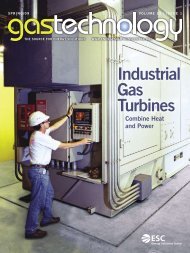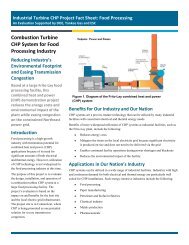Combustion Turbine CHP System for Food Processing Industry
Combustion Turbine CHP System for Food Processing Industry
Combustion Turbine CHP System for Food Processing Industry
Create successful ePaper yourself
Turn your PDF publications into a flip-book with our unique Google optimized e-Paper software.
<strong>Combustion</strong> <strong>Turbine</strong><strong>CHP</strong> <strong>System</strong> <strong>for</strong> <strong>Food</strong><strong>Processing</strong> <strong>Industry</strong>Reducing <strong>Industry</strong>’sEnvironmental Footprintand Easing TransmissionCongestionBased at a large Frito-Lay foodprocessing facility, thiscombined heat and power(<strong>CHP</strong>) demonstration projectreduces the energy costs andenvironmental impact of theplant while easing congestionon the constrained Northeastpower grid.Introduction<strong>Food</strong> processing is a high-growthindustry with tremendous potential <strong>for</strong>combined heat and power (<strong>CHP</strong>)applications because of its need <strong>for</strong>significant amounts of both electricaland thermal energy. However, utilizationof <strong>CHP</strong> technology is not widespread inthe food processing industry at this time.The purpose of this project is to evaluatethe design, installation, and operation ofa combustion turbine <strong>CHP</strong> system at alarge food processing facility. Theproject’s evaluation is based on theimpact on and benefits <strong>for</strong> the host siteand the local electric grid infrastructure.The project site is in Connecticut, where<strong>CHP</strong> is being promoted as one potentialsolution <strong>for</strong> severe transmissioncongestion.Figure 1. Diagram of the Frito-Lay combined heat and power(<strong>CHP</strong>) systemBenefits <strong>for</strong> Our <strong>Industry</strong> and Our Nation<strong>CHP</strong> systems are a proven, mature technology that can be utilized by many industrialfacilities with concurrent electrical and thermal energy needs.Benefits of more widespread utilization of <strong>CHP</strong> systems at industrial facilities, such asthe Frito-Lay plant, include the following:Reduces energy costsMitigates the strain on the local electricity grid because significant electricityis produced on-site and does not need to be delivered via the gridEnables continued facility operations during power shortages and blackoutsReduces the environmental impact of the facility.Applications in Our Nation’s <strong>Industry</strong><strong>CHP</strong> systems can be utilized in a wide range of industrial facilities. Industries with highand continuous demand <strong>for</strong> both electrical and thermal energy are particularly wellsuited <strong>for</strong> <strong>CHP</strong> installations. Such energy-intensive industries include the following:<strong>Food</strong> processingPaper manufacturingPetroleum and biofuel refineriesChemical industryMetals productionPharmaceuticals
Project DescriptionThe <strong>CHP</strong> system was installed at a Frito-Lay facility in Killingly, Connecticut.The system is based on a power islandconcept comprised of a 4.6 megawatt(MW) Solar <strong>Turbine</strong>s Centaur 50 naturalgas combustion turbine and a Rentechheat recovery steam generator equippedwith supplemental duct firing. Thesystem also includes combustion air inletchilling to increase power generation inwarm weather and a selective catalyticemission reduction system.The Frito-Lay plant is a 275,000 squarefoot facility that began operation in 1988and has over 400 employees. It processesover 250,000 pounds (lbs)per day ofboth corn and potatoes <strong>for</strong> snack foods.The plant operates 24 hours a day, sevendays a week. Electricity and steamdemand fluctuate based on productionlevels.The unfired steam production from thegas turbine exhaust is approximately24,000 lb/hour, and maximumsupplementary fired steam production isas high as 60,000 lb/hour. The <strong>CHP</strong>system, designed to be electric loadfollowing, has the capacity to meet100% of the plant’s electrical powerneeds and is also designed to provide amajority of the facility’s annual steamneeds.Per<strong>for</strong>mance of the system was collectedover a 12-month operating period andthe <strong>CHP</strong> system’s energy and economicper<strong>for</strong>mance, its impact on plantoperations and per<strong>for</strong>mance, and itseffect on air emissions were analyzed. Inaddition to the system’s direct emissions,its impact on displaced central stationpower generation emissions was alsodocumented.BarriersDespite the many economic, efficiency,and environmental benefits of <strong>CHP</strong>systems, obstacles to widespreadutilization of the technology in industrystill exist. Major barriers include thefollowing:Need <strong>for</strong> significant upfrontfinancial investmentCommitment to maintaining onsitepower generationIndustries which have nottraditionally utilized <strong>CHP</strong>systems, such as food processing,are seeking in<strong>for</strong>mation on <strong>CHP</strong>economics and benefitsThe relief from recent high andvolatile natural gas prices and theincrease in gas supplies has notbeen recognized by industryPathwaysIn the course of the project, the energy,emissions, reliability, and economicper<strong>for</strong>mance of the <strong>CHP</strong> system wasevaluated and documented over a 12-month operating period. Data analysiswas provided by the Energy SolutionsCenter, Inc. This in<strong>for</strong>mation has provenvaluable <strong>for</strong> understanding the role of<strong>CHP</strong> in providing economic and reliableenergy services <strong>for</strong> small- and mediumsizedindustrial facilities. The projectalso documented the value of <strong>CHP</strong> inproviding benefits to both the industrialfacility and the local electric gridinfrastructure. A case study of thisinstallation has been completed and willbe used to encourage the adoption ofonsite power generation by other foodprocessing facilities. For Frito-Lay, the<strong>CHP</strong> operation and economics exceededtheir expectations.MilestonesJuly 2008: <strong>CHP</strong> system feasibility andengineering plan finishedApril 2009: <strong>System</strong> commissioned ontime.May 2009: Data collection begunMay 2010: Data collection completeOperating data shows the <strong>CHP</strong> systemprovided over 90% of the electricaldemand and about 80% of the steam load<strong>for</strong> the facility. The per<strong>for</strong>mance of the<strong>CHP</strong> system continues to be excellent,with virtually no interruptions inoperation and an overall <strong>CHP</strong> efficiencyof 69% has been achieved.<strong>System</strong> Quick FactsLocation: Killingly, ConnecticutEquipment: 4.6 MW Solar Centaur 50combustion turbine; Rentech heatrecovery steam generatorFuel: Natural gasUse of thermal energy: Steam generationFacility size: 275,000 sq. ft.; over 400employeesElectricity demand: 1,500–3,770 kWSteam demand: 12,000–90,000 lb/hrInstallation date: April 2009Project PartnersFrito-Lay North America, Inc.Principal Engineer: Kevin ChilcoatKevin.Chilcoat@fritolay.comYankee Gaswww.yankeegas.comEnergy Solutions Center, Inc.Washington, DCwww.escenter.orgProject Coordinator: Rich BiljetinaBiljetina@comcast.net







